Electricity in Early Los Angeles
LA's First Municipal Utility PoleThe City of Los Angeles saw the beginning of municipal electric distribution on March 30, 1916 when the Bureau of Power and Light installed its first power pole on the corner of Pasadena Avenue and Piedmont Street. Until then, there were three private electric utilities providing power within the City limits: LA Gas & Electric, Pacific Light & Power, and Southern California Edison. |
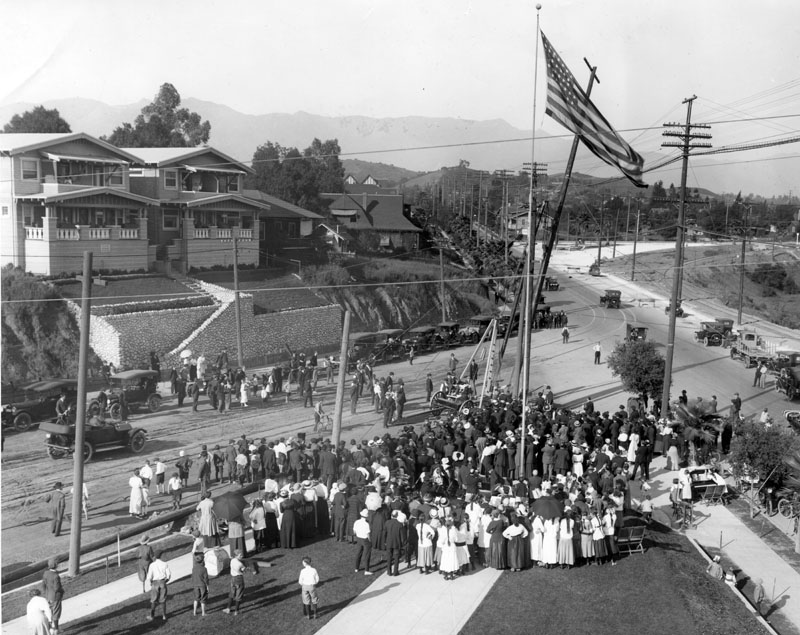 |
| March 30, 1916* - Placing the first electricity pole on Pasadena Avenue (now North Figueroa Street) and Piedmont Street, marking the beginning of municipal distribution of electricity. Click HERE to see more in LA's First Power Pole Installation. |
Historical Notes The first municipal power pole was installed in 1916 to bring electricity, purchased from the City of Pasadena, into Los Angeles. However, things would change within a year. On March 18th, 1917, the Bureau of Power and Light opened its first major hydro-electric power plant, San Francisquito Power Plant No. 1. The plant used water from the recently completed Los Angeles Aqueduct to generate electricity. The LA Bureau of Power and Light would now be able to sell its excess San Francisquito generated power to Pasadena over two newly constructed 34 kV lines between the two cities. By 1917, World War I had forced the price of fuel oil to rise making the new lower cost hydroelectric power extremely desirable. |
* * * * * |
LA's First Power PlantThe first electric light plant in Los Angeles was constructed in 1882 by Charles L. Howland, initially representing a San Francisco based utility called California Electric Light Company (now PG&E). The new plant was located on the corner of Alameda and Banning Streets and was built to provide electricity for the city's new street lights which he also installed. Howland would within a year incorporate with other investors and form his own company, Los Angeles Electric Company. This would become LA's first electric utility. By 1883, Los Angeles became the first city in the USA to entirely abandon gas for street lighting and replace it with electricity. At the time, there were 242 electric lamps with a circuit length of 85 miles. |
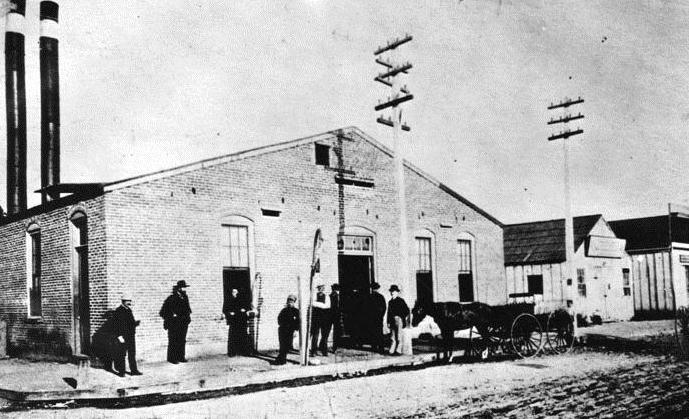 |
| Banning Street Electrical Plant (1888)* -- The first electric light plant in Los Angeles was built in 1882 by C. L. Howland on the corner of Alameda and Banning Streets (One year later, Howland formed the Los Angeles Electric Company). |
Historical NotesIClick HERE to read the story behind LA's first power plant. |
* * * * * |
LA's First Underground Distribution SystemThe use of underground electric distribution in Los Angeles began in 1897 when LA Edison Electric Co., in its first year of operations, installed a system in downtown Los Angeles. The high load density and rapidly growing demand for power in this area made an underground system a practical and economic necessity. In later years LA Gas and Electric Corp. and the Bureau of Power and Light would continue with this practice by installing their own underground system. During the 1920’s, several residential subdivisions in the western part of the City also obtained underground electric services. The developers paid the difference between cost of overhead lines and higher cost of underground installation. Because of the relatively high costs associated with underground installations as compared to overhead installations, the widespread development of underground power lines in Los Angeles did not begin until the mid-50’s. At that time, utilities began to review the former dual objective of low cost and high reliability by including a third objective – appearance. Since that time appearance has become increasingly important. |
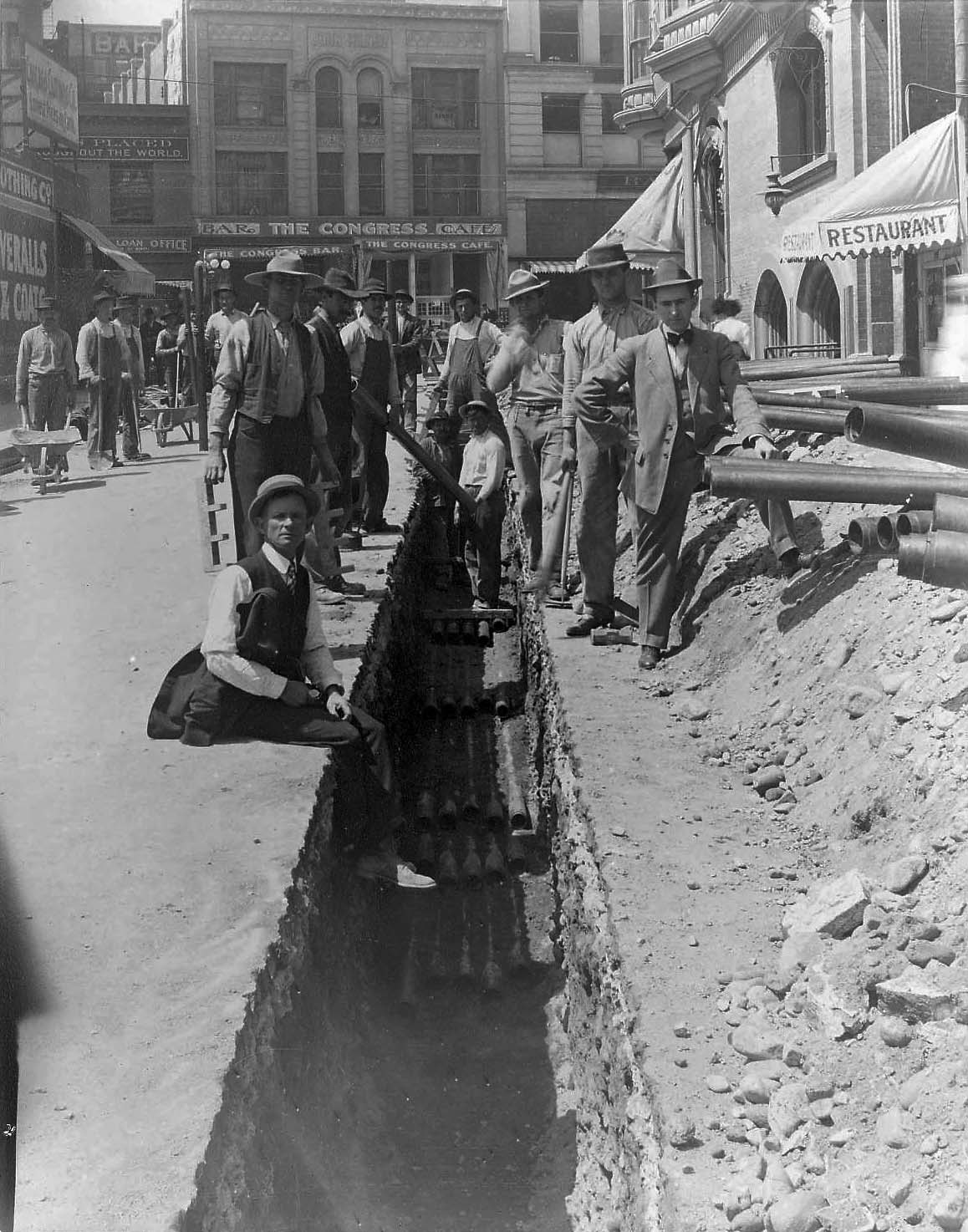 |
|
| (ca. 1897)* – View looking northwest on Winston Street toward where it intersects with Main Street in downtown Los Angeles. An Edison Electric crew is laying conduit for one of LA’s earliest underground electric distribution systems. The building on the right with the two arched windows and a restaurant is the Main Street Savings Bank Building on the N/E corner of Main and Winston streets. |
Historical NotesIn 1896, West Side Lighting Company was organized by private investors to provide another source of electricity for the city of Los Angeles and fringe areas. In 1897, West Side Lighting merged with the newly established private company, Los Angeles Edison Electric, which owned the rights to the Edison name and patents, especially the underground DC-power rights. The merged company took on the Edison name. An underground system and technology was crucial at this time, since the city voted in a resolution limiting the installation of new overhead utility poles due to excessive overhead wire congestion. Los Angeles Edison Electric installed the first major DC-power underground conduits system in the Southwest. Until the late 1930's at least three separate utilities served Los Angeles. |
* * * * * |
Power Needs of a Growing CityAs the City of Los Angeles rapidly grew in the early 1900's, there was an increasing need for electricity, especially for the new electric streetcars that were appearing everywhere. In 1902, Pacific Light and Power Company was organized by the Pacific Electric Red Car and real estate magnate, Henry Huntington. It was set up to provide steam-generated electricity to Huntington's Los Angeles Railway Company. |
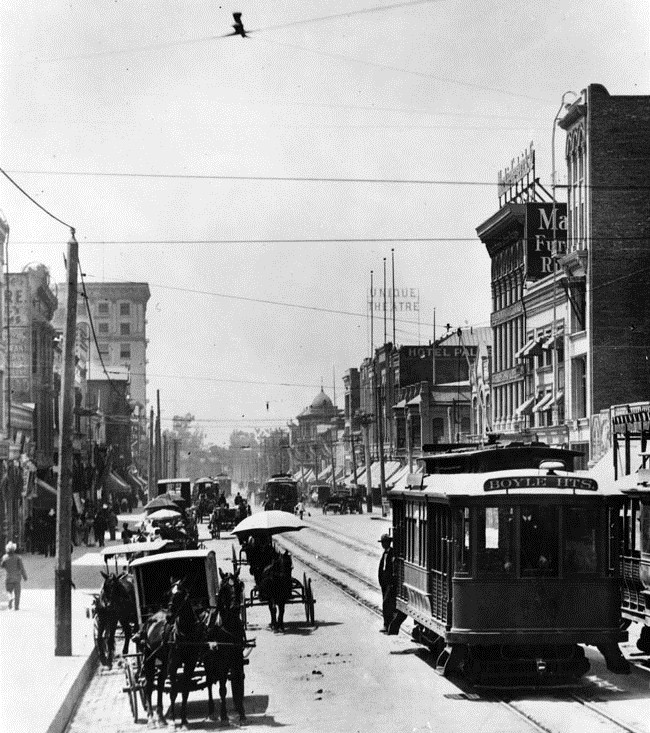 |
|
| (ca. 1905)* - Looking south on Broadway from 5th Street. Pacific Electric "red cars" share the street with horse carts. The electric car is marked "Boyle Hts." |
* * * * * |
Electricity in Early Los Angeles - Historical Timeline |
The period between 1882 and the late 1930’s saw the evolution of the electric utility industry in Los Angeles and its surrounding areas. Start-up private electric companies competed with one another and then with the new municipal utility in town, the Bureau of Power and Light. Not until 1939 did the Department of Water and Power emerge as the sole electrical service provider for the City of Los Angeles. The following timeline takes us back to the first electricity in the City and brings us to a time when the development of the electric utility industry stabilized to a point close to where it is today: |
1882 - A new form of lighting is proposed for Los Angeles by C. L. Howland who represents the San Francisco based company of California Electric Light Company (now PG&E). 1882 (Sept. 11th) - The City Council unanimously votes to enter into a contract with Howland to "illuminate the streets of the city with electric light." 1882 (Dec. 1st) - Howland completes the City's first electric light plant in a period of two months. The 30kw plant is located on the corner of Alameda and Banning Streets (See above photo). 1882 (Dec. 30th) – LA Mayor Homer Toberman throws the switch to send current to the first two arc lights installed by the Los Angeles Electric Company on top of a 150- foot pole at the intersection of Main and Commercial and 1st and Hill (Click HERE to read more). 1883 - The project is so successful that before the expiration of Howland’s two year contract, he and others form the Los Angeles Electric Company, which besides serving streetlights, also supply arc lights for commercial establishments. 1883 – Los Angeles becomes the first city in the USA to entirely abandon gas for street lighting and replace it with electricity. There are 242 electric lamps with a circuit length of 85 miles. 1889 – Los Angeles Electric Company has 235 customers, and powers private lights on the outside of stores. 1890 – Los Angeles Electric Company opens its first alternating-current plant (Los Angeles Electric Company later becomes the Los Angeles Gas and Electric Corporation and survives until it is bought out by the DWP in 1936). 1893 - Los Angeles Electric Company moves its generating station to the corner of Alameda and Palmetto streets. This plant becomes the largest electric light and power plant in Southern California with a total capacity of 2,750 horsepower. The plant generates alternating current for an incandescent lighting system and 500 volt direct current for a power electrical system. 1896 – West Side Lighting Company is organized by private investors to provide another source of electricity for the city of Los Angeles and fringe areas. Click HERE to see more on the West Side Lighting Company. 1897 – West Side Lighting merges with the newly established private company, Los Angeles Edison Electric, which owns the rights to the Edison name and patents, especially the underground DC-power rights. The merged company takes on the Edison name. An underground system and technology is crucial at this time, since the city voted in a resolution limiting the installation of new overhead utility poles due to excessive overhead wire congestion. Los Angeles Edison Electric installs the first major DC-power underground conduits system in the Southwest. 1902 - Pacific Light and Power Company is organized by the Pacific Electric Red Car and real estate magnate, Henry Huntington. It is set up to provide steam-generated electricity to Huntington's Los Angeles Railway Company. 1906 - Pasadena Municipal Light and Power is created by City Ordinance. 1906 (May 3rd) - Pasadena citizens pass a $125,000 bond issue to pay for the construction of a power plant. 1906 - Pasadena Municipal Light and Power constructs its first power plant. It is a 200-kW plant built for furnishing Power for street lighting only. Pasadena is now served by both its new municipal utility and SCE. 1907 – The Kern River-Los Angeles Transmission Line (118 miles and 75 kV) is completed by Los Angeles Edison Electric to bring power to Los Angeles from newly constructed hydroelectric plants in the western side of the Sierras. In 1907 it is the world’s longest and highest voltage power line (188 miles and 75kV). It also is the first transmission line to be entirely supported by steel towers. 1907 - Pacific Light and Power Company constructs its first major power plant in Redondo Beach to provide electricity for the Los Angeles Red Car (also owned by Henry Huntington) and the surrounding area. 1908 - Construction begins on the Los Angeles Aqueduct. LA's first power plant is built at Division Creek in the Owens Valley. The plant generates power from water for the purpose of constructing the LA Aqueduct. This is the first time electric energy has been used for such a construction project. 1909 – Los Angeles Edison Electric changes its name to Southern California Edison. 1909 - The Bureau of Los Angeles Aqueduct Power is created to build hydro power plants along the yet to be completed Los Angeles Aqueduct. When Los Angeles acquired water rights in the Owens Valley section of Inyo County to build the LA Aqueduct, it also obtained water-power sites along the way. 1909 - Ezra F. Scattergood is selected as the Bureau’s first chief electrical engineer. Scattergood leads the way in the development of hydroelectric power along the route of the aqueduct and becomes Mulholland’s counterpart for the Power System. He was the driving spirit in the development of the municipal electric system. 1910 – Los Angeles issues its municipal power bond for preliminary work in connection with electrical power development. City voters approve the project and authorize the $3.5 million bond to finance it. 1911 - The Bureau of Los Angeles Aqueduct Power begins construction of the San Francisquito Power Plant No. 1 to generate power from the anticipated water flow of the yet to be completed LA Aqueduct (The LA Aqueduct was completed in 1913). 1911 – The Department of Public Service and the Public Service Commission are created through an approved charter amendment. 1911 - The Bureau of Power and Light is created within the Department of Public Service to oversee and administer the electrical system in the city. 1911 - Pacific Light and Power Corporation begins building hydroelectric plants in the Big Creek-San Joaquin section of the high Sierras in central California, mostly for power delivery to Southern California, including Los Angeles. 1911 - Mt. Whitney Power and Electric Company builds a hydroelectric plant in the mountains near Visalia, also for power delivery mostly to Southern California. 1913 – Through a charter amendment, the City officially adopts the policy of water and power resources under public ownership. 1914 – $6.5 million of bonds are approved by the voters and issued for the construction of power plants, transmission lines, distribution lines, and for the acquisition of other electric companies’ distribution systems within the city. 1916 (March 30th) – The first power pole in Los Angeles is built by the LA Bureau of Power and Light (see above photo). This is the first time the Bureau of Power and Light delivers electricity in the City. The power, however, is purchased from Pasadena Municipal Power and Light. 1917 (March 18th) - San Francisquito Power Plant No. 1 is placed in service and energy is delivered to Los Angeles over a newly constructed 115 kV transmission line. This is the LA Bureau of Power and Light's first step in becoming an independent electricity provider. Click HERE to read more. 1917 - The LA Bureau of Power and Light sells its excess San Francisquito generated power to Pasadena over two newly constructed 34 kV lines between the two cities. By 1917, World War I had forced the price of fuel oil to rise making the new lower cost hydroelectric power extremely desirable. 1917 – SCE purchases the Pacific Light and Power Corporation, and acquires control of both the Ventura County Power Company and the Mt. Whitney Power Electric Company. After acquiring the properties of both northern utility companies, including the Big Creek project, SCE becomes the major private supplier of electricity in Southern California and the San Joaquin Valley. It now serves over 100 communities with a total population of 1.25 million. 1916 – 1927, Los Angeles expands its boundaries through annexation of large areas and through the consolidation of several small cities. Private utilities (Los Angeles Gas and Electric and Southern California Edison Company) continue to serve the annexed areas as well as some older portions of the city. By 1920 - Los Angeles, Pasadena, Glendale, and Burbank had changed their charters to establish municipal ownership of facilities for generation and distribution of electrical energy. 1920 – Pasadena completes negotiations to purchase SCE’s electrical distribution system within its borders. 1922 - The Bureau of Power and Light purchases the Edison Company’s distribution system within the city limits. SCE’s distribution lines are limited to the territories annexed to the city since 1922, but still furnishes a proportion of the power distributed by the LA Bureau of Power and Light. 1928 - Congress authorizes the Hoover Dam project. 1931 - Los Angeles City is still served electrically by three utilities; LA Bureau of Power and Light, Los Angeles Gas and Electric, and Southern California Edison. 1931 - Construction begins on the Hoover Dam project by a consortium called Six Companies, Inc. Click HERE to see more on the construction of Hoover Dam. 1933 - Scattergood negotiates a 10-year federal loan for $22,799,00 to build a power transmission line from Boulder Dam to Los Angeles. 1933 - The Los Angeles Bureau of Power and Light begins construction of the 266-mile long transmission line between Boulder Dam and Los Angeles. 1934 - A bond measure to refinance the Boulder original 10-year loan to a 40-year loan is approved by LA voters in a special election. 1935 (September 30) – Hoover Dam is dedicated by President Franklin Roosevelt. 1936 (March 1st) – Hoover dam is turned over to the federal government from Six Companies, more than two years ahead of schedule. 1936 - Construction of the 266-mile Boulder-Los Angeles transmission line is completed. Click HERE to read more. 1936 (October 9th) – Los Angeles receives the first power from Boulder Dam. The electricity is transmitted at a higher voltage (287 kV) than any other long-distance transmission line in the world, to date. Boulder Dam begins to deliver enough electricity to meet 70% of Los Angeles' needs. 1936 (December) – Los Angeles city voters approve a charter amendment authorizing the Bureau of Power and Light to issue revenue bonds in the amount of $46 million and purchase the electric system of Los Angeles Gas and Electric Corporation, the last remaining privately-owned system in LA. 1937 (Jan. 29th) – The Bureau of Power and Light completes the purchase of Los Angeles Gas and Electric Corporation. Click HERE to read more. 1937 - The Bureau of Power and Light consolidates with the Bureau of Water Works and Supply and becomes the Los Angeles Department of Water and Power (LADWP). 1939 – SCE and LADWP complete negotiations on the division of territory between the two utilities. 1939 (August) – SCE swaps the remainder of its Los Angeles distribution system for facilities outside the city limits (formerly owned by Los Angeles Gas and Electric). 1939 to Present – SCE supplies the unincorporated areas within Los Angeles County and all other municipalities except for Pasadena, Glendale, and Burbank. 1939 to Present - DWP becomes the sole electrical service provider for the City of Los Angeles.
Notes After 1947, through a Los Angeles City charter change, City voter approval is no longer required for the DWP to issue bonds. |
* * * * * |
Flow Chart: History of Electric Utilities in Los Angeles
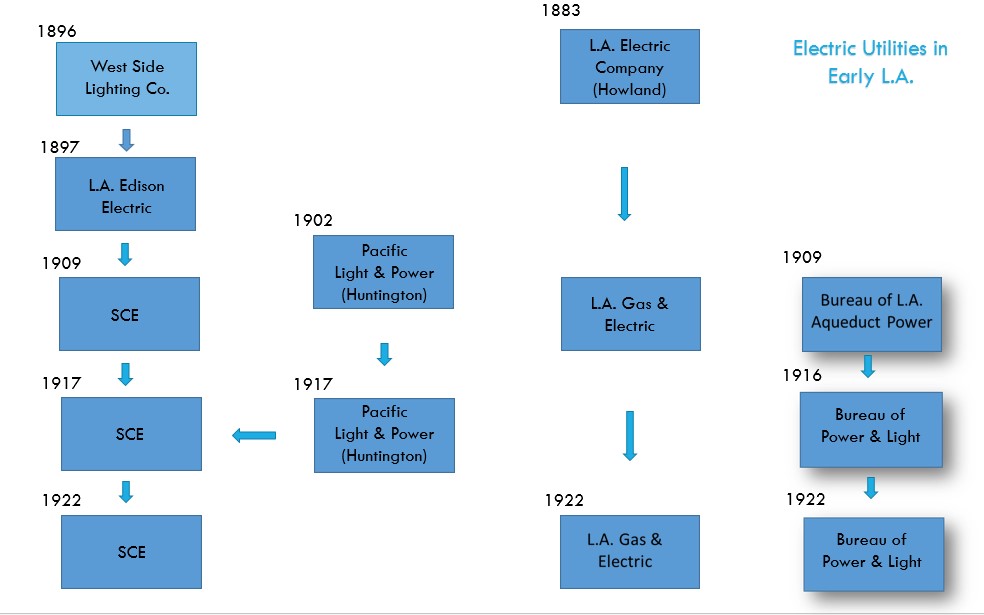 |
|
| Flow Chart showing the evolution of Los Angeles' Electric Utilities from 1883 to 1922. |
Historical Notes In 1922, The Bureau of Power and Light purchased the Southern California Edison Company’s (SCE) distribution system within the city limits. SCE’s distribution lines were limited to the territories annexed to the city since 1922, but still furnished a proportion of the power distributed by the LA Bureau of Power and Light. |
.jpg) |
|
| Flow Chart showing the evolution of electric utilities within Los Angeles from 1922 to Present. |
Historical Notes In 1936, with the opening of Hoover Dam, The Bureau of Power and Light had all the electrical power it needed to serve the City and become self-sufficient. In 1937, The Bureau of Power and Light completed the purchase of Los Angeles Gas and Electric Corporation. The Gas business was sold off and became Southern California Gas Compnay. Click HERE to see more in Los Angeles Gas and Electric Corporation. Also, in 1937, The Bureau of Power and Light consolidated with the Bureau of Water Works and Supply to become The Los Angeles Department of Water and Power (LADWP), the largest Municipal Utility in the U.S. In 1939, DWP became the sole electrical service provider for the City of Los Angeles. Click HERE to see the Evolution of LA's Water Service Providers |
* * * * * |
Please Support Our CauseWater and Power Associates, Inc. is a non-profit, public service organization dedicated to preserving historical records and photos. Your generosity allows us to continue to disseminate knowledge of the rich and diverse multicultural history of the greater Los Angeles area; to serve as a resource of historical information; and to assist in the preservation of the city's historic records.
|
History of Water and Electricity in Los Angeles
More Historical Early Views
Newest Additions
Early LA Buildings and City Views
* * * * * |
References and Credits
Southern California Metropolis: A Study in Development of Government for a Metropolitan Area - 1963 by Winston Winford Crouch and Beatrice DinermanNational Municipal Review, Volume 20, Issue 12, pages 729-732, December 1931
Plugged In: The History of Power in Los Angeles, USC Library Archive
A History of the Chamber of Commerce of Los Angeles, California - 1899, by Charles Dwight Willard
City of Los Angeles Records Inventory Report
The Influence of the Los Angeles “Oligarchy” on the Governance of the Municipal Water Department
John Randolph Haynes, California Progressive - 1991, by Tom Sitton
Lehman Brothers Collection - Southern California Edison Company
Southern California Public Authority - LADWP
Daily Breeze Article (10-5-11)
Los Angeles Water and Power History
* DWP - LA Public Library Image Archive
^#Huntington Digital Library Archive
< Back
Menu
- Home
- Mission
- Museum
- Major Efforts
- Recent Newsletters
- Historical Op Ed Pieces
- Board Officers and Directors
- Mulholland/McCarthy Service Awards
- Positions on Owens Valley and the City of Los Angeles Issues
- Legislative Positions on
Water Issues
- Legislative Positions on
Energy Issues
- Membership
- Contact Us
- Search Index